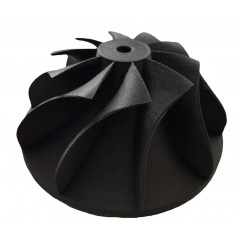Package contains: 1 x CARBONX PA12+CF [CARBON FIBER NYLON] - Black / 1.75mm / 500g - 3DXTech
CarbonX? PA12 carbon fiber is made from high modulus carbon fiber and a special nylon 12 (PA12) chosen for its printability, thermal properties and chemical resistance. PA12+CF is widely used in a variety of industries due to its excellent chemical resistance, low moisture absorption and wide processing window. Our formulation provides very low shrinkage in the molded part resulting in excellent dimensional stability, making our PA12+CF an excellent choice for instruments, devices and masks.
Benefits of PA12+CF include:
High thermal properties, with CUT of 120°C and HDT of 150°C
Excellent strength and stiffness over a wide temperature range, up to 150°C
Very low moisture absorption ensuring better retention of mechanical properties even when exposed to humid environments
Low density makes it ideal for lightweight parts
Superior chemical resistance, especially compared to PA6 nylons
Low shrinkage and warpage for high dimensional stability and reproducible part-to-part measurements
Filament Specifications:
Diameter: 1.75 mm (+/- 0.05 mm)
Recommended print settings:
Extruder: 265-285°C
Platen temperature: 90-110°C
Nozzle: we currently recommend a hardened steel nozzle with a minimum diameter of 0.4 mm
Other: the ideal layer height is 60% of the nozzle diameter. We do not recommend printing layers smaller than 0.2 mm with carbon fiber reinforced filaments
Platen preparation: we recommend the use of an adhesive or poly tape
Heated chamber: recommended
Substrates: the water-soluble universal substrate material AquaTek? X1 water-soluble USM is designed to work with complex models
Drying instructions: 90°C for 4 hours
Abrasive material
This material is particularly abrasive among 3D printing filaments. Users may find that standard brass nozzles are chewed up very quickly compared to standard wear. If worn, the nozzle diameter will expand inconsistently and the printer will encounter extrusion problems.
For this reason, we strongly recommend printing this material through a hardened steel nozzle rather than a softer metal. Hardened steel nozzles can often be inexpensive and easy to install depending on the printer manufacturer's instructions.






![CARBONX PA12+CF [CARBON FIBER NYLON] - Black / 1.75mm / 500g - 3DXTech Carbon 3DXTech 19210040 3DXTech CARBONX PA12+CF [CARBON FIBER NYLON] - Black / 1.75mm / 500g - 3DXTech Carbon 3DXTech 19210040 3DXTech](https://www.dhm-online.com/4900127-home_default/carbonx-pa12-cf-carbon-fiber-nylon-black-175mm-500g-3dxtech.jpg)
![CARBONX PA12+CF [CARBON FIBER NYLON] - Black / 1.75mm / 500g - 3DXTech Carbon 3DXTech 19210040 3DXTech CARBONX PA12+CF [CARBON FIBER NYLON] - Black / 1.75mm / 500g - 3DXTech Carbon 3DXTech 19210040 3DXTech](https://www.dhm-online.com/4900127-large_default/carbonx-pa12-cf-carbon-fiber-nylon-black-175mm-500g-3dxtech.jpg)


![CARBONX PA6+CF GEN 3 [CARBON FIBER NYLON] - Black / 1.75mm / 500g - 3DXTech Carbon 3DXTech 19210041 3DXTech](www.dhm-online.com/4900128-home_default/carbonx-pa6-cf-gen-3-carbon-fiber-nylon-black-175mm-500g-3dxtech.jpg)


![CARBONX CF PEKK-A [AEROSPACE] - Black / 1.75mm - 3DXTech 500g Carbon 3DXTech 19210035 3DXTech](www.dhm-online.com/4900124-home_default/carbonx-cf-pekk-a-aerospace-black-175mm-3dxtech-500g.jpg)





